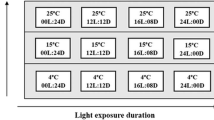Abstract.
Thirteen orange-pigmented bacteria associated with cyanobacterial mat samples collected from four different lakes in McMurdo, Antarctica, were isolated. Twelve of the isolates, which were coccoid in shape, were very similar and possessed all the characteristics of the genus Planococcus and represented a new species, which was assigned the name Planococcus antarcticus sp. nov. (CMS 26orT). Apart from the phenotypic differences, P. antarcticus differed from all reported species of Planococcus by more than 2.5% at the 16S rRNA gene sequence level. In addition, at the DNA–DNA hybridization level, it exhibited very little similarity either with P. mcmeekinii (30%–35%), P. okeanokoites (26%–29%), or CMS 53orT (15%–25%), the three species with which it is closely related at the rRNA gene sequence level (2.5%–2.9%). P. antarcticus also showed only 2.5% difference in its 16S rRNA gene sequence compared with the P. alkanoclasticus sequence. But it was distinctly different from P. alkanoclasticus, which exists only as rods, is mesophilic and phosphatase positive, can hydrolyze starch, cannot utilize succinate, glutamate, or glucose, and cannot acidify glucose. Most important, P. antarcticus and P. alkanoclasticus varied distinctly in their fatty acid composition in that C15:0, C15:1, C16:0, iso-C16:1, and C17:0 were present only in P. antarcticus but absent in P. alkanoclasticus. CMS 53orT, the thirteenth isolate, was also identified as a new species of Planococcus and was assigned the name Planococcus psychrophilus sp. nov. This species was distinctly different from all the reported species, including the new species P. antarcticus, with respect to a number of phenotypic characteristics. At the 16S rRNA gene sequence level, it was closely related to P. okeanokoites (98.1%) and P. mcmeekinii (98%), but with respect to the DNA–DNA hybridization, the similarity was only 35%–36%. The type strain of P. antarcticus is CMS 26orT (MTCC 3854; DSM 14505), and that of P. psychrophilus is CMS 530rT (MTCC 3812; DSM 14507).
Similar content being viewed by others
Author information
Authors and Affiliations
Additional information
Electronic Publication
Rights and permissions
About this article
Cite this article
Reddy, .G., Prakash, .J., Vairamani, .M. et al. Planococcus antarcticus and Planococcus psychrophilus spp. nov. isolated from cyanobacterial mat samples collected from ponds in Antarctica. Extremophiles 6, 253–261 (2002). https://doi.org/10.1007/s00792-001-0250-7
Received:
Accepted:
Issue Date:
DOI: https://doi.org/10.1007/s00792-001-0250-7




